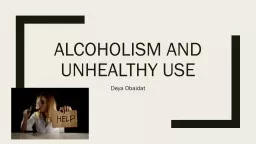

Deya Obaidat How to measure alcohol intake The unit of consumption Drink 12 Oz of beer or wine cooler 5 Oz of wine 15 Oz distilled spirit The effect of alcohol Vary from one person to another Weight Gender Genetics Rapidity of consumption presence of food Tolerance ID: 908467
Download Presentation The PPT/PDF document "Alcoholism and unhealthy use" is the property of its rightful owner. Permission is granted to download and print the materials on this web site for personal, non-commercial use only, and to display it on your personal computer provided you do not modify the materials and that you retain all copyright notices contained in the materials. By downloading content from our website, you accept the terms of this agreement.
Slide1
Alcoholism and unhealthy use
Deya Obaidat
Slide2How to measure alcohol intake
The unit of consumption = Drink = 12 Oz of beer or wine cooler = 5 Oz of wine = 1.5 Oz distilled spirit
Slide3Slide4The effect of alcohol
Vary from one person to another. (Weight, Gender, Genetics, Rapidity of consumption, presence of food, Tolerance)
The amount of alcohol in the body can be measured by Blood Alcohol Content
- measures how many grams of alcohol in 100 gram of blood
- to convert that to mg/dl, multiply it by 1000
- alcohol in the breath gives an estimate of the blood level
In USA you are legally intoxicated if BAC > 0.08% (80 mg/
dL
)
2 standard drinks will increase your BAC by 0.05%
> 300 mg/
dL
are lethal
Increase mortality if >2-3 drinks daily in females, or >3-4 drinks in males
Slide5Slide6Medical Complications of exessive
alcohol
CVS: arrhythmia (A-fib), CMO
GI: GERD/Barrett’s, pancreatitis, Hepatitis and cirrhosis
Metabolic:
lytes
abnormalities (hypophosphatemia), alcoholic ketoacidosis, osteoporosis
NM: Wernicke’s ,
Korsakoff
, cerebellar degeneration, peripheral neuropathy, seizures, Gout
Moderate amounts: reduce the risk of heart dx, DM2, dementia,
Slide7How much alcohol is too much alcohol?
Almost 50% of adults report drinking in the last year, 23% report binging in one occasion or more in the last month, 6% heavy drink use binging x5 in the last month
Binge drink >= 5 drinks at one day
Unhealthy use of alcohol: alcohol misuse, problem drinking, at-risk drinking ..
etc
Drinks limit for a healthy person by NIAAA:
Slide8Alcoholism
Def by
American Society of Addiction
Medicine:
primary, chronic disease with genetic, psychosocial, and environmental factors influencing its development and
manifestations, characterized
by impaired control over drinking, preoccupation with the drug alcohol despite adverse consequences, and distortions in thinking, most notably denial. Each of these symptoms may
be
continuous or
periodic
DSM IV: alcohol abuse, alcohol dependence
DSM V: Substance abuse disorder (Mild = abuse, Moderate to severe = dependence or alcoholism)
Slide9DSM V criteria of substance abuse disorder
Slide10Screening tools for dependence
AUDIT
CAGE
10 Items
4 items
Every question has different
score
Eye
opener test is the most specific
Detect
unhealthy alcohol use and alcoholism
Detect moderate to sever
e (dependence)
>8 means alcohol problem
>2 means a problem
Slide11AUDIT - C
Only the first 3 items of AUDIT , which deals with quantity and pattern
As sensitive and specific as the full AUDIT
A score of >= 3 , sensitivity of 98% for heavy drinking, 90% of alcohol use disorder, but a specificity of 60%
Slide12CAGE
Positive if >=2 , if = 1 needs further evaluationSensitivity of 74%, specificity of 91%
Cut down question is the most sensitive, but Eye opener is the most specific
Additional question of asking when was the last time you had X number of drinks, if the answer was within the last month, increase the specificity
Slide13Counseling
Studies showed brief counseling effective in a 4 year span
3 components: Feedback, advice and goal setting
The goal is to limit and not to stop drinking, except for alcoholics
Moderate to severe needs more counseling
Start by confronting the patient -> initial response is denial
Slide14Alcohol withdrawal syndrome
Slide15/Detoxification
If mild to moderate symptoms => out pt
settings
If severe =>
inpt
setting
Who will develop DTs and need
inpt
detox?
- moderate to severe withdrawal
- previous DT or seizure
- inability to cooperate with daily follow up
- comorbid medical or psych
Dx
that requires hospitalization
- inability to take meds by mouth due to nausea or vomiting
- unsuccessful previous outpatient detox
Slide16//TT of withdrawal
BDZ first line, barbiturate can be used as well
Most patients will need 3 days of TT, some will need weeks
No evidence of superiority of one BDZ over the other
Slide17//
cont’
Fixed dose
vs
PRN : showed no superiority in mild to moderate symptoms, no max dose
Even with the fixed doses you still have to asses the patient and give extra PRN doses
Slide18Slide19Relapse preventing
AA meeting , psychotherapy (cognitive behavioral), residential treatment
Pharmacotherapy : Adjacent to the ones above
-
Disulfiram
: needs supervised setting, no effectiveness on the long run, hepatotoxic
- Naltrexone (opioid-antagonist) : modest reduction, no significance
= injectable form (
vivitrol
): reduce heavy drinking days, modest effect, no need for abstinence from alcohol to begin with it, can’t use w/ opioid dependent patients
-
Acamprosate
(GABA analogue) : alone or w/ naltrexone, abstinence required
-
Topiramate
: not FDA approved, under study, could be use in
abstinenece
or w/o
Slide20Slide21Questions?